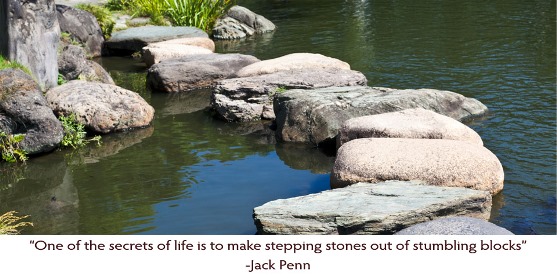From Stumbling Blocks to Stepping Stones.
When Krishna Venkatesh, a musician who wrote the score for the Yoga documentary movie Enlighten Up, suffered a serious back injury in 2008, he began a Yoga practice, searching for relief.
He explored Iyengar and Ashtanga practices, and eventually found the Stone Center for Yoga and Health in Teaneck, New Jersey, outside New York City. He immersed himself in the study of Stone Yoga, an adaptive, therapeutic approach accredited by the Yoga Alliance, in time resolving his back pain.
He returned to the music world, recently producing a groove remix chant CD with David Durga Das Newman, but in the meantime began teacher training at Stone Yoga. After completing his studies, the newly registered Yoga teacher began working, with a focus on precise, but case-sensitive alignment.
That the eponymous Charlotte Stone of Stone Center teaches yoga, much less trains teachers, would have been difficult, if not impossible, to predict in 1973, when she began her Yoga journey as a student at the University of Zurich.
“I was born in Philadelphia, but my father was Swiss. We moved to Switzerland when I was 10 years old.
I was studying medieval literature and English, working part-time for an advertising agency, and doing competitive sports. I was stressed out. One of my friends said, ‘You’ve got to do Yoga, because you’re driving all of us crazy.’ He gave me a book called Yoga 28 Day Exercise Plan. After 28 days, I could just about touch my knees.”
A weightlifter and swimmer, she was undeterred.
“I’ll be damned if I fail at Yoga,” she recalls thinking.
Going into action was her method for dealing with failure. She found Sivananda Yoga teachers near the university in Zurich and began attending classes.
Sivananda Yoga is a traditional system concentrating not only on exercise, but breathing, relaxation, meditation, and diet as well.
“They kept saying, ‘Close your eyes, focus on your breath,’ and I kept saying, ‘When are we going to get to the good stuff, moving, sun salutations?’ I always skipped Savasana because I thought it was a total waste of my 10 minutes.
I didn’t understand the benefits of it. But, I stuck with it.”
Nothing takes the place of persistence. After a year, she was able to touch her toes. She continued her efforts and eventually entered into an informal apprenticeship.
“They slowly but surely allowed me to ease my way into learning more.”
But, they warned her against ever teaching Yoga to others.
“You must never teach Yoga,” one of her teachers told her. “You are too competitive. You’re going to kill all your students. Never teach Yoga, no, no, no.”
But, within a year, with their blessing, she was teaching an occasional Sunday morning class.
“I really fell in love with it,” she says.
She studied with physical therapists, medical students, and delved into Iyengar Yoga.
“If I was going to tell people how to stand, how to move, I wanted to know more about physical alignment.”
After returning to the United States in 1977, enrolling at the City University of New York to pursue her Master’s degree, and meeting her future husband, she taught power-style Vinyasa Yoga part-time at gyms.
She also taught at a small ballet school near Lincoln Center.
“The school was run by a Russian lady, and one day she looked in on what the girls and I were doing. It did not go well,” Charlotte Stone remembers.
“What are you doing, teaching girls to relax? They are ballet dancers, must never relax! What is belly breathing? No belly breathing in ballet! They must suck belly in!”
“I regarded that as my exit cue,” she says.
In the next 10 years, she married, had two children, and worked in advertising, concentrating on focus groups, and later becoming a moderator and analyst.
“We worked on issues like what shade of red should the next Maxwell House label be, which was apparently a vitally important question at the time. But, I do have to say I loved my work. I learned how to really listen and pay attention.”
She continued to regularly practice Yoga, her own Ashtanga-based practice deepening, and continued to teach part-time.
Then, in the late 1980s, she was involved in a serious car accident, which curtailed her professional career.
“A truck and I had a close encounter on the George Washington Bridge, and the truck won.”
After recovering from her immediate injuries, she was in physical therapy for the next eight months.
“It sidelined my ability to travel. I also developed repetitive strain syndrome in my hands from writing so much. I was only able to consult every now and then.”
She fell back on her Yoga practice, which brought out a side of healing that even her physical therapy couldn’t. She took gentle Yoga classes at Kripalu.
“It helped open my eyes to people like me, who had injuries.”
She began to share her newly adaptive style of Yoga with others.
“I found, if I can’t write full-time, Yoga is the only other thing I know how to do, so I did that. Whenever I brought it up, it always fascinated everyone. They would ask, what do you like about it, what can it do for me?
The Yoga began to take off, and I finally decided to put my money where my mouth was and get formally trained.”
She enrolled with Phoenix Rising Yoga Therapy, a Vermont-based training program that combines old-school yogic wisdom with contemporary dialogue techniques with the aim of guiding practitioners to their edge of deep physical sensation, inviting insights about their lives off the mat.
“It was an eye-opener,” she says.
In 1991, she opened a small studio in Teaneck.
“All my friends said they were tired of moving furniture around in our family room for classes. I thought I’m going to give it a shot.”
Within five years, she had trained as a Structural Yoga teacher, then as a Structural Yoga therapist, and moved the studio to larger quarters. She increasingly worked with people suffering from chronic pain and illness.
“It’s based on anatomy and physiology, with a grounding in Ayurveda, and goes far beyond saying, do Yoga three times a week and call me in the morning,” says Charlotte Stone.
“It’s being present for the person and inviting a change to occur. I feel what changed for me happened when I was seriously injured. I realized this body is very precious, that no breath should be taken for granted. It was a huge, huge change in my thinking about Yoga.”
While recovering, she wondered how she would teach.
Her anatomy instructor told her, “Now you’re going to become a really good teacher.”
The art of teaching is the art of awakening the mind and spirit, for both student and teacher.
“I used to think Yoga was a great sport. Over time, I came to understand it is much more. In the Yoga Sutras, it says Yoga should be ‘steady and comfortable’. If you look at some of our Yoga today, it doesn’t look steady, and it certainly doesn’t look comfortable. It almost makes me want to send letters of apology to my early students,” she says.
A member of the International Association of Yoga Therapists, Charlotte Stone blends her experience of Structural Yoga with the adaptive approach of Viniyoga, the principles of Ayurvedic balance, and the organic movements of Feldenkrais, which is a method of communicating with the unconscious through movement.
“Our motto is, your Yoga your way,” she said, explaining her multi-discipline approach. “It’s not about what you can’t do. It’s about what you can do. The practice needs to meet you where you are.”
Stone Yoga’s emphasis is on alleviating pain, reducing stress, and enhancing well-being at every level.
“Every day I’ve been granted after my accident, I think, there’s a reason I’m here. It began with me, peeling away all the illusions of who I was. It ended by working with others, who, like me, had to rebuild themselves.”
Out of past beginnings had come a new beginning.
*****
Postscript: In 2014 Charlotte Stone began a new project, expanding Stone Yoga, recently voted #1 in her community for the second year in a row. “It’s exciting,” she said about adding another practice room. When asked what priorities she was assigning the new space, she replied, “The space will teach us what it’s there for.”
*****


